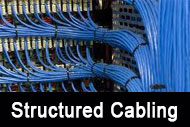Structured Cabling
 TRC provides structured cabling solution that meets your unique needs. Your one true network infrastructure solution.
TRC provides structured cabling solution that meets your unique needs. Your one true network infrastructure solution.
True End-to-End Solutions
Now your complete network infrastructure needs are met by a single provider. TRC structured cabling solutions deliver proven cable, connectivity, and cable management solutions. from category 3 voice and category5e Data, category 6 including fiber from the data center to the desktop.
True Performance
With TRC Cabling solutions you can push networks to the performance edge. Innovative products that exceed industry standards support advanced applications today and tomorrow.
True Reliability
Mission-critical networks rely upon trusted infrastructure. Built and tested in ADC's world-class facilities, TRC is backed Warranty that guarantees assures your infrastructure is up and working each and every day.
What Is Structured Cabling?
Structured cabling is a 'standards' based method of engineering and installing an integrated data, voice and video cabling system for your business. A properly designed and installed structured cabling system provides you with a cabling infrastructure that delivers predictable performance as well as flexibility to accommodate growth and change over an extended period of time. Additionally, a structured cabling system provides a uniform, open physical cabling topology that can simultaneously support multiple logical networking topologies for different applications such as Ethernet, token-ring, ATM or video.
voice and video cabling system for your business. A properly designed and installed structured cabling system provides you with a cabling infrastructure that delivers predictable performance as well as flexibility to accommodate growth and change over an extended period of time. Additionally, a structured cabling system provides a uniform, open physical cabling topology that can simultaneously support multiple logical networking topologies for different applications such as Ethernet, token-ring, ATM or video.
Your initial investment in a 'standards' based structured cabling system will return many benefits including an extended operational lifespan, predictable performance, manageability and growth. These benefits bring increased efficiency, improved productivity and reduced costs to you and your business.
Category 5e
suitable for network installations with bandwidth requirements up to 100Mbps.
100BASE-T uses two pairs of a four pair cable for communication. Considered a minimum performance requirement for cabling technology. Category 5e (enhanced) suitable for network installations to 100Mbps with headroom for future 1000BASE-T network standards. Needed for applications using all four cable pairs and full duplex transmission such as 1000BASE-T. Provides higher margin over category 5 wiring.
Advantages:
One of the main advantages of a Cat 5 / Cat 5E installation for businesses is the ease with which staff can be relocated. A simple change to patching can facilitate transfer the staff-member's data and phone connection to the new location.
Category 5 cable also has the advanatage of being able to operate in noisy environments. For example, server rooms often have power grids, U.P.S.'s telephone systems all co-located, yet the Cat 5 solution still functions effectively
What Are 'Standards' And Why Are They Important ?
Domestic and international standards organizations have been formed to ensure that manufactured products meet certain quality, safety and performance 'norms' for that category and class of product. Standards organizations such as ISO/IEC, TIA/EIA, CENELEC and CSA have created and published standards for structured cabling components and systems, and their specifications for Category 5, Category 5e and proposed specifications for Category 6 systems are widely used and accepted in the industry today.

Category 5 recommendations were developed in the early 1990’s to define the use of low cost Unshielded Twisted Pair (UTP) cabling and components in a structured cabling system with performance parameters specified up to 100 MHz.
Category 5e specifications, also referred to as Enhanced Category 5, were developed at the end of the ’90s to meet the demands of more sophisticated networking applications such as Gigabit Ethernet and to take advantage of significant advances in UTP cabling system engineering and manufacturing technologies. Today, the Category 5e standard is generally accepted as the minimum requirement for data applications in new cabling system installations, and it is anticipated that most standards organizations will recommend the use of the Category 5 standard in lieu of all earlier standards for voice networking applications.
The constant need for faster and more efficient network applications will, inevitably, result in the need for higher performance structured cabling systems. Standards organizations around the world are already working on developing a new Category 6 standard to define enhanced performance parameters beyond the current scope of Category 5e specifications. Current Category 6 proposals define channel bandwidth at 200 MHz or greater, providing at least twice the bandwidth of Category 5e systems and ensuring support for tomorrow’s multi-gigabit networking applications.
For end-users, the challenge will be in selecting a structured cabling system that will meet both current and future needs. Whether those needs indicate the use of Category 5e or Category 6 systems, end-users should look for systems that not only meet but exceed the specifications of each respective standard, thereby providing additional performance margins to accommodate the evolution of ever more demanding networking needs.
RECENT BLOG POST
CONTACT US
.jpg)
Telecom Resource Corporation
70 Connie Cresent, Units 2 & 3
Vaughan,On
L4K 1L6
Tel.: 416-398-4448
Fax: 905.695.2260
Info@trcnetworks.com
Contact us now
REQUEST A DEMO
Let us help you find a phone system that fits your needs and demonstrate to you how it can transform your business
-
 What is Cisco BE...
What is Cisco BE...
04.19.25 - Cisco Business Edition 6000 (BE 6000) is a packaged solution...
-
 Avaya Aura a Cos...
Avaya Aura a Cos...
04.19.25 - Avaya Aura® is a breakthrough in business communicatio...
-
 What Is Cisco Ev...
What Is Cisco Ev...
04.19.25 - The Cisco Evolved Services Platform (ESP) is a comprehensi...

.png)

.jpg)
.jpg)
.jpg)

.jpg)
Comments
Post Your Comment